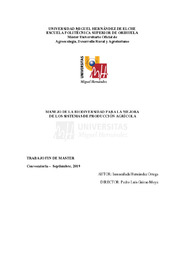Por favor, use este identificador para citar o enlazar este ítem:
https://hdl.handle.net/11000/5409Registro completo de metadatos
| Campo DC | Valor | Lengua/Idioma |
|---|---|---|
| dc.contributor.advisor | Guirao Moya, Pedro | - |
| dc.contributor.author | Hernández Ortega, Inmaculada | - |
| dc.date.accessioned | 2019-10-29T15:14:06Z | - |
| dc.date.available | 2019-10-29T15:14:06Z | - |
| dc.date.created | 2019-09 | - |
| dc.date.issued | 2019-10-29 | - |
| dc.identifier.uri | http://hdl.handle.net/11000/5409 | - |
| dc.description.abstract | Las infraestructuras ecológicas del tipo “seto vivo” constituyen un manejo de la biodiversidad mediante el uso de especies vegetales autóctonas las cuales van a proveer de recursos alimenticios a la fauna auxiliar beneficiosa siendo refugio de la misma durante todo el año. El número de plagas que afectan a los cultivos continúa aumentando y el uso de setos es una herramienta que puede colaborar en el control dichas plagas de forma ecológica y sostenible. La revisión bibliográfica que se realiza en el presente Trabajo Fin de Máster, nos ayudará a entender cuáles han sido las especies entomológicas encontradas en estos setos, la selección de especies vegetales empleadas y las técnicas de manejo para poder realizar infraestructuras que regularán poblaciones de insectos fitófagos ayudando a la conservación y restauración de la biodiversidad para una agricultura más sostenible. Palabras clave: restauración, biodiversidad, infraestructura ecológica, manejo hábitat, biodiversidad funcional. | es |
| dc.description.abstract | The ecological infrastructures of the “hedgerow” type establish a biodiversity handling through the use of indigenous plant species which will provide food resources for the beneficial auxiliary wildlife, being shelter for said wildlife throughout the year. The number of pests that affect the crops keeps rising and the use of hedges is a tool that can cooperate in the control of said pests in an ecologically friendly and sustainable way. The bibliographic review that is performed in this final dissertation will help us understand which ones have been the entomological species found in these hedges, the selection of plant species used and the handling techniques to be able to carry out infrastructures that will regulate phytophagous insect stocks, helping the conservation and restoration of the biodiversity for a more sustainable agriculture. | es |
| dc.format | application/pdf | es |
| dc.format.extent | 53 | es |
| dc.language.iso | spa | es |
| dc.rights | info:eu-repo/semantics/openAccess | es |
| dc.subject | Biodiversidad | es |
| dc.subject | Producción agrícola | es |
| dc.subject.other | CDU::6 - Ciencias aplicadas::63 - Agricultura. Silvicultura. Zootecnia. Caza. Pesca::633 - Cultivos y producciones | es |
| dc.title | Manejo de la biodiversidad para la mejora de los sistemas de producción agrícola | es |
| dc.type | info:eu-repo/semantics/masterThesis | es |

Ver/Abrir:
TFM Hernández Ortega, Inmaculada.pdf
2,63 MB
Adobe PDF
Compartir:
 La licencia se describe como: Atribución-NonComercial-NoDerivada 4.0 Internacional.
La licencia se describe como: Atribución-NonComercial-NoDerivada 4.0 Internacional.
.png)